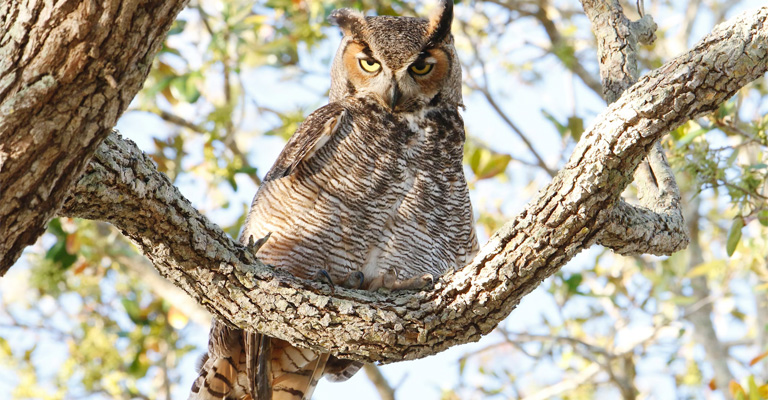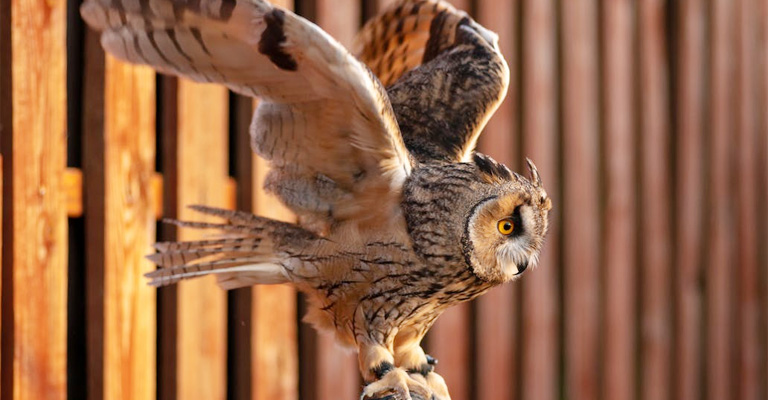Owls are available in 254 species all over the world. Among different species, the great horned owl (Scientific Name: Bubo virginianus) has captured our attention for a long time and for special reasons.
We all know owls are birds of prey, meaning they hunt and feed on small animals for daily nutrition. The great horned owl, however, takes their lifestyle one step ahead and has become our point of article today!
They are truly remarkable creatures of the night. If you avoid great horned owl behavior and their unique lifestyle, your interest in owls will be left mostly void!
**Note that, by behavior, we simply can’t focus on only one aspect of the owls’ nature. Habitat, diet, mating rituals, and adaptations – everything combined define the behavior of a living creature.
We will open up one by one. Let’s start.

Did You Know?
- Native to America, the great horned owls equally wander around North and South America, sometimes the Arctic too.
- They can live up to 5 to 15 years in the wild. But in captivity, they may extend up to 20 years.
- Great horned owls are pro-hunters, renowned for their stealth. They can fly silently due to specialized wing feathers, almost noiseless.
- They generally hunt mammals like rabbits and rodents. But it’s also not unusual to feed on skunks, ducks, and even other raptors like smaller owls.
- They are ambush predators. The mottled plumage and tufted “horns” help them blend seamlessly into their surroundings.
- Additionally, the great horned owls are also known for their incredibly strong talons. They are capable of exerting almost any pressure
Physical Identities:
Bird sighting is often fun and educative. Look for the features below to identify a great horned owl next time you see it.
Weight: 0.9 to 2.5 Kg
Length: 1.5 to 2.1 ft
Wingspan: 3 to 5 ft
Tail length: 0.5 to 0.8 ft
Special Features:
Horns: One of the most unique features of the great horned owl is its large, tufted “horns” or ear tufts. It’s, in fact, not an ear at all. They offer better communication and better camouflage.
Large Eyes: The big, forward-facing eyes offer excellent night vision. They can seamlessly hunt in low-light environments. Additionally, the binocular sight is similar to ours and helps them measure right.
Sound Knowledge: They have a keen sense of hearing. Mark that, unlike most other birds, the Great Horned Owls have asymmetrical ear openings, with one higher on the head than the other. It helps them to pinpoint the source of the sound even in complete darkness.
Great Horned Owl Behavior

We will explore different behavior traits of this remarkable owl. But one by one! Let’s start with habitats and regions first.
Where Do the Great Horned Live?
The great horned owls can survive in almost any environment – forest, grasslands, deserts, and even urban nature. They generally live throughout the North and South America. The zone expands from the Arctic tundra to the dense forests of the Amazon basin.
The owls are known for their solitary nature and territorial behavior. Might not be so common in birds, but horned owls set up territories that may range from a few square miles to over 10 square miles.
It’s important to highlight that, the owls are highly territorial. They will defend and protect their territory by any means, even if they have to act aggressively. Not any intruders, not even other great horned owls are free of this fury!
What Do the Great Horned Owl Eat?
They are super clever predators. To fill up their need for protein, they depend on a versatile diet, including mammals, birds, reptiles, worms, spiders, and even other owls!!!
However, you would usually notice them hunt down other prey animals such as mice, voles, rabbits, and even raccoons.
But, what sets them apart as hunters? The great horned owls are sharp and strike silently. Their feathers are specially designed and have gone through years of evolution to reduce flight noise. They can make moves for their prey with stealth.
Do They Mate for Life?
Here’s our insightful article on whether owls mate for life or not. For now, let’s highlight specifically the breeding nature of the great horned owls.
On average, the great horned owls live about 5 to 15 years. At age 2, they reach maturity, and their sexual desire becomes more dominant. Soon after, they engage in courtship, a special set of behaviors and rituals between a male and a female bird.
They bow, droop wings, sing, and call each other in preparation for mating and reproduction. The great horned owls usually find the nest, rather than building it from scratch.
Often crows or hawks abandon their nest which makes them an ideal option for these owls. Both male and female partner share their parental duties equally.
Both the male and female owls incubate the eggs equally. However, the female partner spends more time raising the offspring. On the contrary, the male owl looks for food and brings them to his family.
The couple usually have 2 to 4 eggs once and spend 26 to 35 days for incubation.
It takes one and a half months for the young ones to start to walk. They learn to completely fly after two and a half months. The great horned owls are quite sincere and raise one family a year. The young ones usually leave their nest by autumn.
In Short,
We learn from nature. The unique formation of the great horned owl can teach us a lot about precise hunting and how to survive in tough weather. Additionally, the overall great horned owl behavior promotes the secret of survival and protection.
What do you think? Would you ever try to approach the nest of a great horned owl after all you have learned here today? I don’t think so!
Let us know in the comment box, what you think of the beautiful birds of prey. You can also share our articles with other bird lovers and help us grow. See you in our next guide!